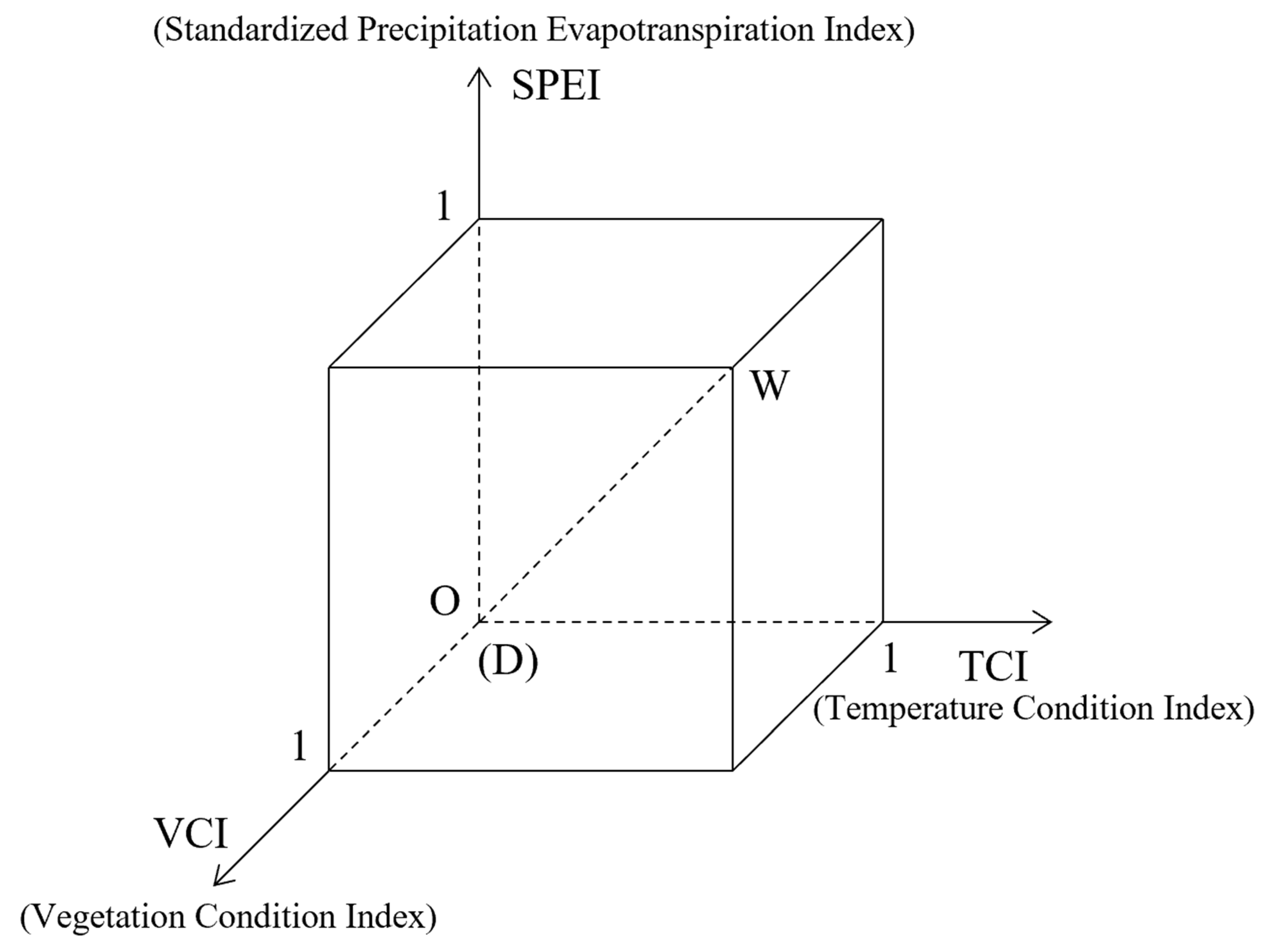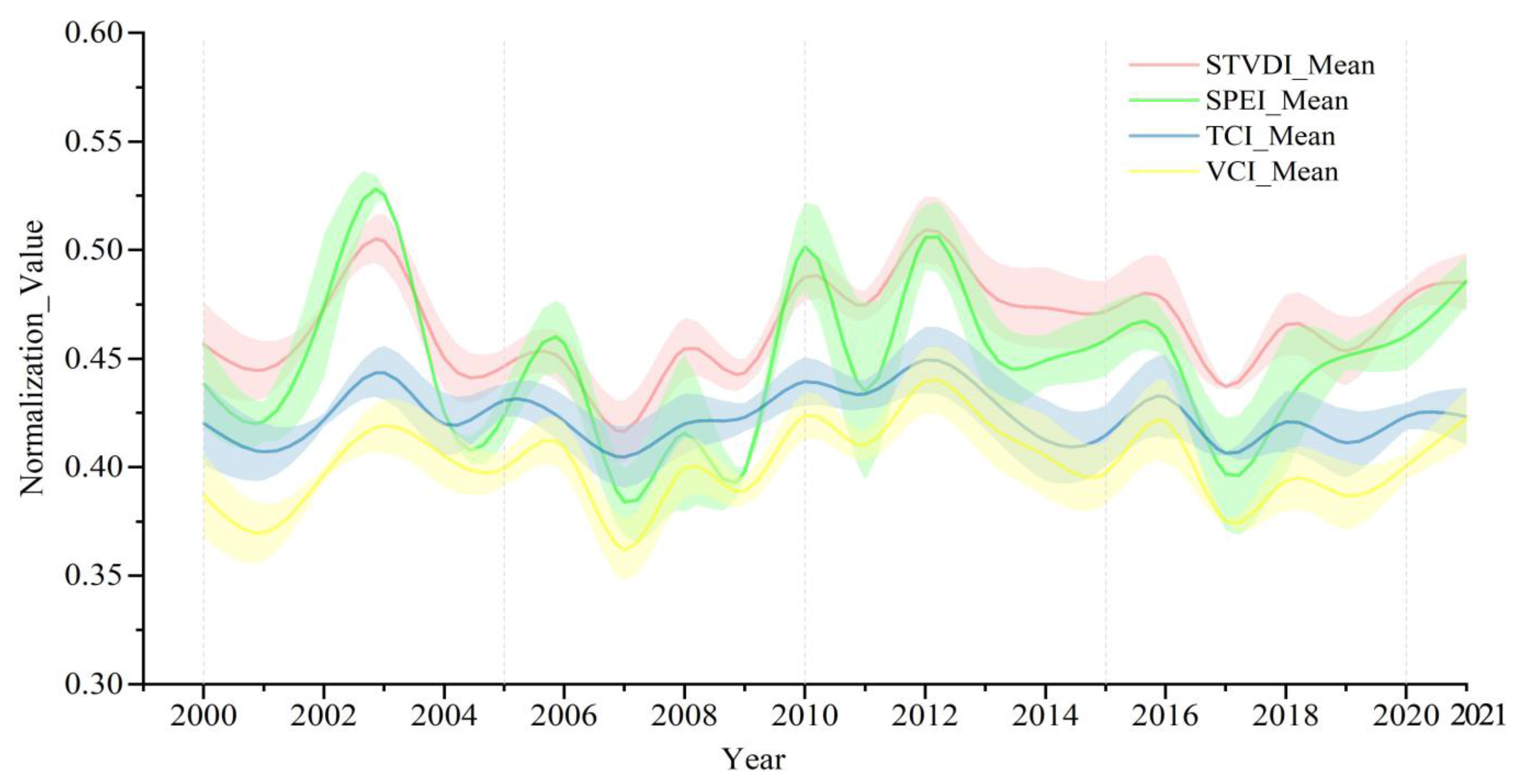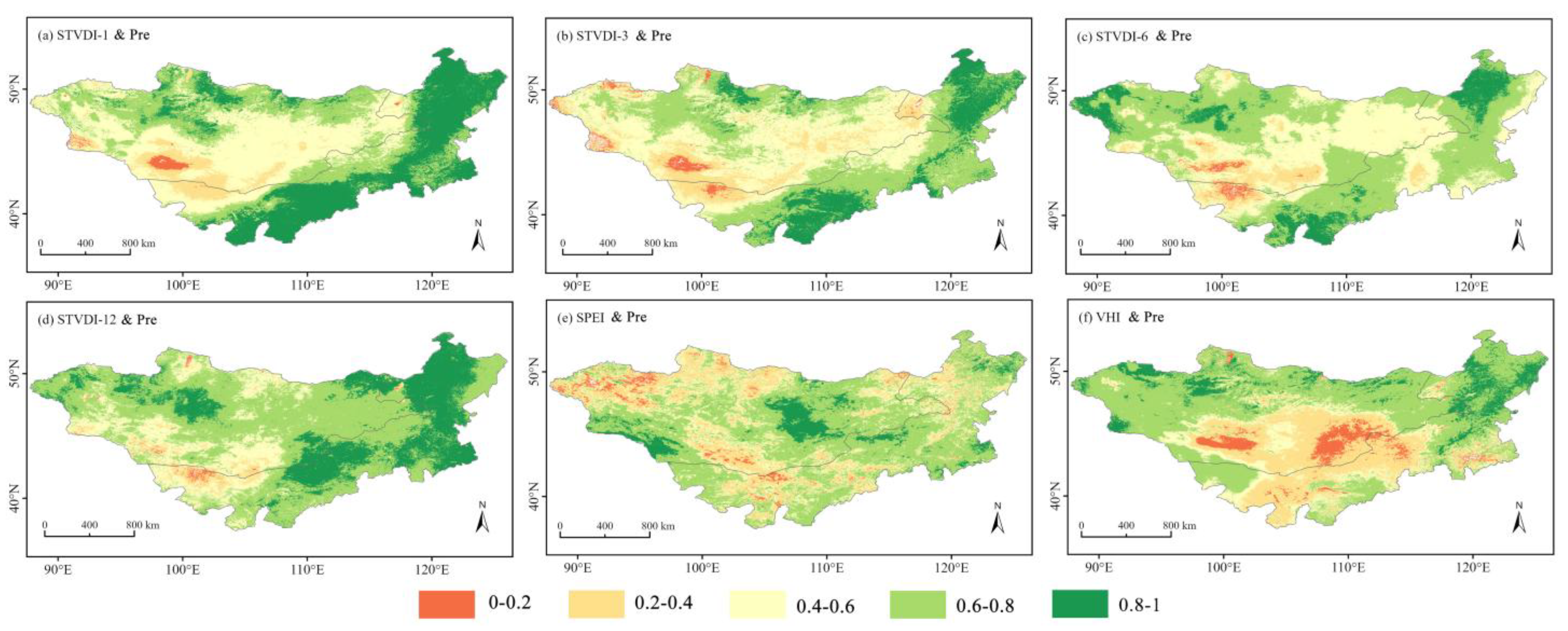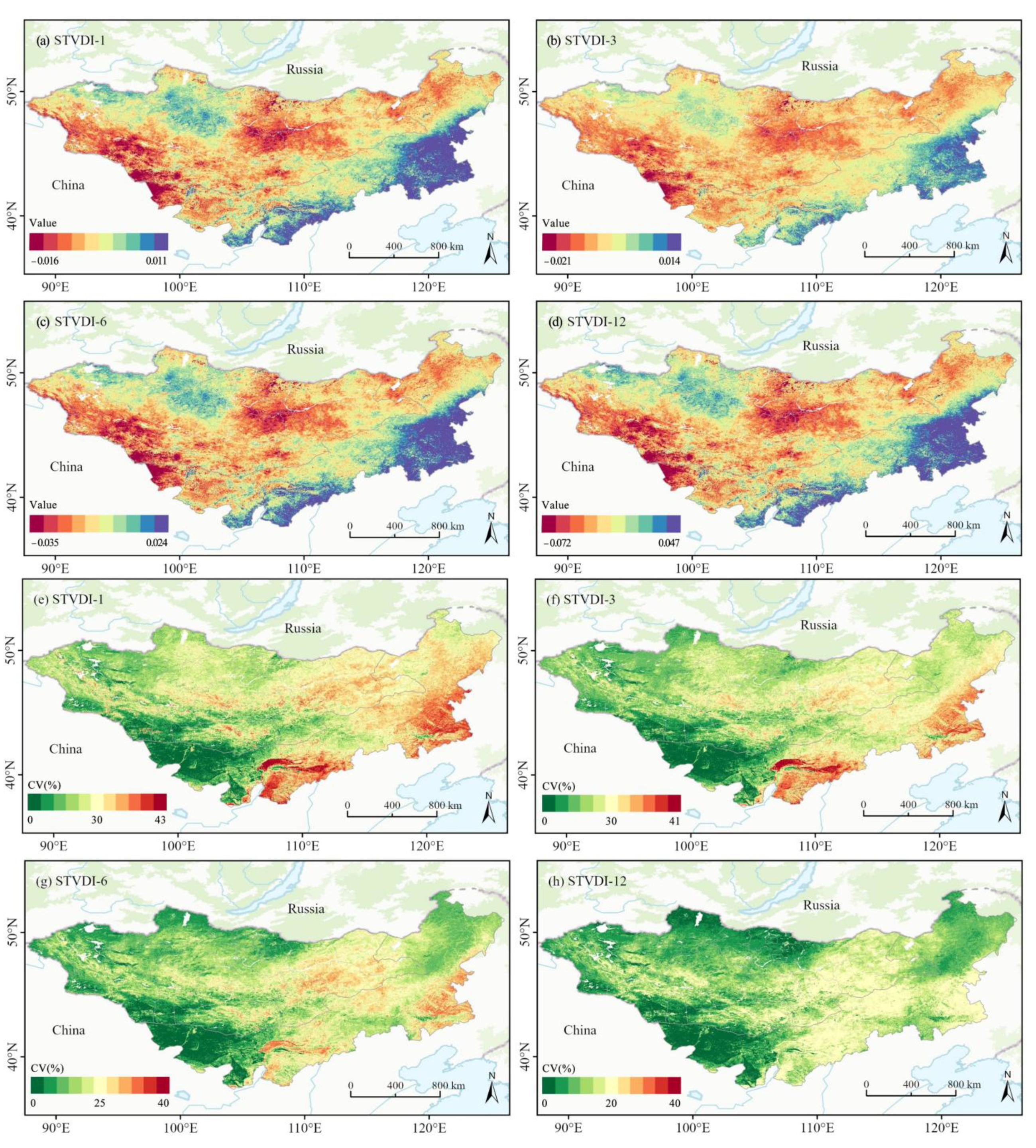A Novel Composite Drought Index with Low Lag Response for Monitoring Drought Features on the Mongolian Plateau
Highlights
- The Mongolian Plateau is revealed to be under persistent threat from frequent flash droughts (2000–2021).
- The standard precipitation evapotranspiration–temperature–vegetation drought index (STVDI) proves highly effective due to its rapid response to precipitation and soil moisture changes.
- The STVDI is established as a robust drought monitoring tool specifically for arid and semi-arid regions.
- A new, fine-resolution (1-km) monthly drought dataset was provided to aid ecological and disaster management.
Abstract
1. Introduction
2. Materials and Methods
2.1. Study Area

2.2. Data and Processing
2.2.1. MODIS Data
2.2.2. Meteorological Data
2.3. Methods
2.3.1. Drought Indices

2.3.2. Spatial Correlation Coefficient
2.3.3. Sen’s Slope Estimator
2.3.4. Nash–Sutcliffe Efficiency Coefficient
2.3.5. Coefficient of Variation
2.3.6. Cross-Correlation Function
2.3.7. Hurst Index
3. Results
3.1. Evaluation of the STVDI
3.1.1. Spatiotemporal Consistency of the STVDI, SPEI, TCI and VCI


3.1.2. Relationships Between the STVDI, Pre, SM, SPEI, and VHI


3.1.3. Comparison Between the STVDI Across Different Time Scales



3.2. Spatiotemporal Distribution and Change Trend of Drought
3.2.1. Drought Monitoring Based on Monthly STVDI


3.2.2. Drought Monitoring Based on Annually STVDI


4. Discussion
4.1. Performance Evaluations of the STVDI
4.2. Spatiotemporal Features and Lag Response of Drought on the MP
4.3. Limitations
5. Conclusions
Author Contributions
Funding
Data Availability Statement
Acknowledgments
Conflicts of Interest
References
- Nairizi, S. Drought and Water Scarcity; International Commission on Irrigation and Drainage: New Delhi, India, 2017. [Google Scholar]
- Ault, T.R. On the essentials of drought in a changing climate. Science 2020, 368, 256–260. [Google Scholar] [CrossRef]
- Yuan, X.; Wang, Y.; Ji, P.; Wu, P.; Sheffield, J.; Otkin, J.A. A global transition to flash droughts under climate change. Science 2023, 380, 187–191. [Google Scholar] [CrossRef] [PubMed]
- Baluch, H. Global Aridity Trends, Impacts, and Adaptation Strategies. In The Global Threat of Drying Lands: Regional and Global Aridity Trends and Future Projections; UNCCD: Bonn, Germany, 2024. [Google Scholar]
- Hoover, D.L.; Smith, W.K. The growing threat of multiyear droughts. Science 2025, 387, 246–247. [Google Scholar] [CrossRef] [PubMed]
- Wu, H.; Su, X.; Huang, S.; Singh, V.P.; Zhou, S.; Tan, X.; Hu, X. Decreasing dynamic predictability of global agricultural drought with warming climate. Nat. Clim. Change 2025, 15, 411–419. [Google Scholar] [CrossRef]
- Monjo, R.; Royé, D.; Martin-Vide, J. Meteorological drought lacunarity around the world and its classification. Earth Syst. Sci. Data 2020, 12, 741–752. [Google Scholar] [CrossRef]
- Guo, Y.; Huang, S.; Huang, Q.; Leng, G.; Fang, W.; Wang, L.; Wang, H. Propagation thresholds of meteorological drought for triggering hydrological drought at various levels. Sci. Total Environ. 2020, 712, 136502. [Google Scholar] [CrossRef]
- McKee, T.B.; Doesken, N.J.; Kleist, J. The relationship of drought frequency and duration to time scales. In Proceedings of the 8th Conference on Applied Climatology, Anaheim, CA, USA, 17–22 January 1993; Volume 17, pp. 179–183. [Google Scholar]
- Byun, H.-R.; Wilhite, D.A. Objective Quantification of Drought Severity and Duration. J. Clim. 1999, 12, 2747–2756. [Google Scholar] [CrossRef]
- Van-Rooy, M.P. A rainfall anomaly index (RAI) independent of time and space. Notos 1965, 14, 43–48. [Google Scholar]
- Gommes, R.A.; Petrassi, F. Rainfall Variability and Drought in Sub-Saharan Africa Since 1960; FAO: Rome, Italy, 1994; 100p. [Google Scholar]
- Bhalme, H.N.; Mooley, D.A. Large-Scale Droughts/Floods and Monsoon Circulation. Mon. Wea. Rev. 1980, 108, 1197–1211. [Google Scholar] [CrossRef]
- Palmer Wayne, C. Meteorological drought, U.S. Weather Bur. Res 1965, 45, 1–58. [Google Scholar]
- Vicente-Serrano, S.M.; Beguería, S.; López-Moreno, J.I. A Multiscalar Drought Index Sensitive to Global Warming: The Standardized Precipitation Evapotranspiration Index. J. Clim. 2010, 23, 1696–1718. [Google Scholar] [CrossRef]
- West, H.; Quinn, N.; Horswell, M. Remote sensing for drought monitoring & impact assessment: Progress, past challenges and future opportunities. Remote Sens. Environ. 2019, 232, 111291. [Google Scholar]
- Zhang, Y.; Hao, Z.; Feng, S.; Zhang, X.; Xu, Y.; Hao, F. Agricultural drought prediction in China based on drought propagation and large-scale drivers. Agric. Water Manag. 2021, 255, 107028. [Google Scholar] [CrossRef]
- Idso, S.B.; Jackson, R.D.; Pinter, P.J.; Reginato, R.J.; Hatfield, J.L. Normalizing the stress-degree-day parameter for environmental variability. Agric. Meteorol. 1981, 24, 45–55. [Google Scholar] [CrossRef]
- Kogan, F.N. Remote sensing of weather impacts on vegetation in non-homogeneous areas. Int. J. Remote Sens. 1990, 11, 1405–1419. [Google Scholar] [CrossRef]
- Kogan, F.N. Application of vegetation index and brightness temperature for drought detection. Adv. Space Res. 1995, 15, 91–100. [Google Scholar] [CrossRef]
- Zeng, J.; Zhou, T.; Qu, Y.; Bento, V.A.; Qi, J.; Xu, Y.; Li, Y.; Wang, Q. An improved global vegetation health index dataset in detecting vegetation drought. Sci. Data 2023, 10, 338. [Google Scholar] [CrossRef]
- Thornthwaite, C.W. An Approach toward a Rational Classification of Climate. Geogr. Rev. 1948, 38, 55. [Google Scholar] [CrossRef]
- Narasimhan, B.; Srinivasan, R. Development and evaluation of Soil Moisture Deficit Index (SMDI) and Evapotranspiration Deficit Index (ETDI) for agricultural drought monitoring. Agric. For. Meteorol. 2005, 133, 69–88. [Google Scholar] [CrossRef]
- Wang, L.; Qu, J.J. NMDI: A normalized multi-band drought index for monitoring soil and vegetation moisture with satellite remote sensing. Geophys. Res. Lett. 2007, 34, 2007GL031021. [Google Scholar] [CrossRef]
- Svoboda, M.; LeComte, D.; Hayes, M.; Heim, R.; Gleason, K.; Angel, J.; Rippey, B.; Tinker, R.; Palecki, M.; Stooksbury, D.; et al. The Drought Monitor. Bull. Amer. Meteor. Soc. 2002, 83, 1181–1190. [Google Scholar] [CrossRef]
- Brown, J.F.; Wardlow, B.D.; Tadesse, T.; Hayes, M.J.; Reed, B.C. The Vegetation Drought Response Index (VegDRI): A New Integrated Approach for Monitoring Drought Stress in Vegetation. GIScience Remote Sens. 2008, 45, 16–46. [Google Scholar] [CrossRef]
- Alahacoon, N.; Edirisinghe, M. A comprehensive assessment of remote sensing and traditional based drought monitoring indices at global and regional scale. Geomat. Nat. Hazards Risk 2022, 13, 762–799. [Google Scholar] [CrossRef]
- Chang, F.J.; Wang, K.W. A systematical water allocation scheme for drought mitigation. J. Hydrol. 2013, 507, 124–133. [Google Scholar] [CrossRef]
- Zhan, C.; Liang, C.; Zhao, L.; Jiang, S.; Zhang, Y. Differential responses of crop yields to multi-timescale drought in mainland China: Spatiotemporal patterns and climate drivers. Sci. Total Environ. 2024, 906, 167559. [Google Scholar] [CrossRef] [PubMed]
- Zhu, X.; Huang, S.; Singh, V.P.; Huang, Q.; Zhang, H.; Leng, G.; Gao, L.; Li, P.; Guo, W.; Peng, J. Terrestrial ecosystem resilience to drought stress and driving mechanisms thereof in the Yellow River Basin, China. J. Hydrol. 2025, 649, 132480. [Google Scholar] [CrossRef]
- En-Nagre, K.; Aqnouy, M.; Ouarka, A.; Ali Asad Naqvi, S.; Bouizrou, I.; Eddine Stitou El Messari, J.; Tariq, A.; Soufan, W.; Li, W.; El-Askary, H. Assessment and prediction of meteorological drought using machine learning algorithms and climate data. Clim. Risk Manag. 2024, 45, 100630. [Google Scholar] [CrossRef]
- Wang, Y.; Liu, G.; Guo, E. Spatial distribution and temporal variation of drought in Inner Mongolia during 1901–2014 using Standardized Precipitation Evapotranspiration Index. Sci. Total Environ. 2019, 654, 850–862. [Google Scholar]
- Tong, S.; Lai, Q.; Zhang, J.; Bao, Y.; Lusi, A.; Ma, Q.; Li, X.; Zhang, F. Spatiotemporal drought variability on the Mongolian Plateau from 1980–2014 based on the SPEI-PM, intensity analysis and Hurst exponent. Sci. Total Environ. 2018, 615, 1557–1565. [Google Scholar]
- Li, H.; Hu, Y.; Ao, Z. Identification of critical drought thresholds affecting vegetation on the Mongolian Plateau. Ecol. Indic. 2024, 166, 112507. [Google Scholar] [CrossRef]
- Cao, X.; Feng, Y.; Shi, Z. Spatio-temporal Variations in Drought with Remote Sensing from the Mongolian Plateau During 1982–2018. Chin. Geogr. Sci. 2020, 30, 1081–1094. [Google Scholar] [CrossRef]
- Bole, Y.; Guga, S.; Riao, D.; Zhang, J.; Tong, Z.; Liu, X. Emergency constraint-based CMIP6 predictions for future droughts on the Mongolian Plateau. J. Hydrol. 2024, 645, 132156. [Google Scholar] [CrossRef]
- Tirivarombo, S.O.D.E.; Osupile, D.; Eliasson, P. Drought monitoring and analysis: Standardised precipitation evapotranspiration index (SPEI) and standardised precipitation index (SPI). Phys. Chem. Earth 2018, 106, 1–10. [Google Scholar] [CrossRef]
- Bento, V.A.; Gouveia, C.M.; DaCamara, C.C.; Trigo, I.F. A climatological assessment of drought impact on vegetation health index. Agric. For. Meteorol. 2018, 259, 286–295. [Google Scholar] [CrossRef]
- Tyagi, S.; Zhang, X.; Saraswat, D.; Sahany, S.; Mishra, S.K.; Niyogi, D. Flash drought: Review of concept, prediction and the potential for machine learning, deep learning methods. Earth’s Future 2022, 10, e2022EF002723. [Google Scholar] [CrossRef]
- Christian, J.I.; Hobbins, M.; Hoell, A.; Otkin, J.A.; Ford, T.W.; Cravens, A.E.; Powlen, K.A.; Wang, H.; Mishra, V. Flash drought: A state of the science review. Wiley Interdiscip. Rev. Water 2024, 11, e1714. [Google Scholar] [CrossRef]
- Shi, H.; Li, T.; Wei, J. Evaluation of the gridded CRU TS precipitation dataset with the point raingauge records over the Three-River Headwaters Region. J. Hydrol. 2017, 548, 322–332. [Google Scholar] [CrossRef]
- Ullah, S.; You, Q.; Sachindra, D.A.; Nowosad, M.; Ullah, W.; Bhatti, A.S.; Jin, Z.; Ali, A. Spatiotemporal changes in global aridity in terms of multiple aridity indices: An assessment based on the CRU data. Atmos. Res. 2022, 268, 105998. [Google Scholar] [CrossRef]
- Zhang, J.; Wei, W.; Pang, S.; Guo, Z.; Li, Z.; Zhang, X.; Wang, J. Monitoring and assessment of drought in arid area in northwest China based on FY-3C and TRMM Data. Chin. J. Ecol. 2020, 39, 690–702. [Google Scholar]
- Sharma, V.; Kilic, A.; Irmak, S. Impact of scale/resolution on evapotranspiration from Landsat and MODIS images. Water Resour. Res. 2016, 52, 1800–1819. [Google Scholar] [CrossRef]
- Li, Y.; Gong, H.; Chen, W.; Wang, L. Attribution of drought trends on the Mongolian Plateau over the past decades. Environ. Res. Lett. 2024, 19, 074034. [Google Scholar] [CrossRef]
- Guan, Y.; Gu, X.; Slater, L.J.; Li, J.; Kong, D.; Zhang, X. Spatio-temporal variations in global surface soil moisture based on multiple datasets: Intercomparison and climate drivers. J. Hydrol. 2023, 625, 130095. [Google Scholar] [CrossRef]
- Zhang, L.; Jiao, W.; Zhang, H.; Huang, C.; Tong, Q. Studying drought phenomena in the Continental United States in 2011 and 2012 using various drought indices. Remote Sens. Environ. 2017, 190, 96–106. [Google Scholar] [CrossRef]
- Zeng, J.; Zhang, R.; Qu, Y.; Bento, V.A.; Zhou, T.; Lin, Y.; Wu, X.; Qi, J.; Shui, W.; Wang, Q. Improving the drought monitoring capability of VHI at the global scale via ensemble indices for various vegetation types from 2001 to 2018. Weather. Clim. Extrem. 2022, 35, 100412. [Google Scholar] [CrossRef]
- Pei, F.; Wu, C.; Liu, X.; Li, X.; Yang, K.; Zhou, Y.; Wang, K.; Xu, L.; Xia, G. Monitoring the vegetation activity in China using vegetation health indices. Agric. For. Meteorol. 2018, 248, 215–227. [Google Scholar] [CrossRef]
- Bento, V.A.; Gouveia, C.M.; DaCamara, C.C.; Libonati, R.; Trigo, I.F. The roles of NDVI and Land Surface Temperature when using the Vegetation Health Index over dry regions. Glob. Planet. Change 2020, 190, 103198. [Google Scholar] [CrossRef]
- Almouctar, M.A.S.; Wu, Y.; Zhao, F.; Qin, C. Drought analysis using normalized difference vegetation index and land surface temperature over Niamey region, the southwestern of the Niger between 2013 and 2019. J. Hydrol. Reg. Stud. 2024, 52, 101689. [Google Scholar] [CrossRef]
- Gumus, V. Evaluating the effect of the SPI and SPEI methods on drought monitoring over Turkey. J. Hydrol. 2023, 626, 130386. [Google Scholar] [CrossRef]
- Li, J.; Li, Y.; Zhao, Q. Land Surface Temperature Based Soil Moisture Dynamics Modeling for Chinese Mainland. IEEE Geosci. Remote Sens. Lett. 2022, 19, 1–5. [Google Scholar] [CrossRef]
- Yin, M.; Yin, Y.; Zong, X.; Deng, H. Global vegetation vulnerability to drought is underestimated due to the lagged effect. Agric. For. Meteorol. 2025, 364, 110451. [Google Scholar] [CrossRef]
- Li, C.; Fu, Y.; Zhao, Q.; Zhang, X.; Ding, R.; Hao, F.; Yin, G. Climatic driving mechanisms of the propagation from meteorological drought to agricultural and ecological droughts. J. Environ. Manag. 2025, 383, 125445. [Google Scholar] [CrossRef]
- Cao, M.; Chen, M.; Liu, J.; Liu, Y. Assessing the performance of satellite soil moisture on agricultural drought monitoring in the North China Plain. Agric. Water Manag. 2022, 263, 107450. [Google Scholar] [CrossRef]
- Pei, W.; Hao, L.; Fu, Q.; Ren, Y.; Li, T. The standardized precipitation evapotranspiration index based on cumulative effect attenuation. J. Hydrol. 2024, 635, 131148. [Google Scholar] [CrossRef]
- Wang, S.; Fu, B.J.; Gao, G.Y.; Yao, X.L.; Zhou, J. Soil moisture and evapotranspiration of different land cover types in the Loess Plateau, China. Hydrol. Earth Syst. Sci. 2012, 16, 2883–2892. [Google Scholar] [CrossRef]
- Jeong, M.-S.; Park, S.-Y.; Kim, Y.-J.; Yoon, H.-C.; Lee, J.-H. Identification of propagation characteristics from meteorological drought to hydrological drought using daily drought indices and lagged correlations analysis. J. Hydrol. Reg. Stud. 2024, 55, 101939. [Google Scholar] [CrossRef]
- Shi, X.; Chen, F.; Shi, M.; Ding, H.; Li, Y. Construction and application of Optimized Comprehensive Drought Index based on lag time: A case study in the middle reaches of Yellow River Basin, China. Sci. Total Environ. 2023, 857, 159692. [Google Scholar] [CrossRef]
- Li, M.; Wang, P.; Tansey, K.; Sun, Y.; Guo, F.; Zhou, J. Improved field-scale drought monitoring using MODIS and Sentinel-2 data for vegetation temperature condition index generation through a fusion framework. Comput. Electron. Agric. 2025, 234, 110256. [Google Scholar] [CrossRef]
- Ivanov, V.Y.; Fatichi, S.; Jenerette, G.D.; Espeleta, J.F.; Troch, P.A.; Huxman, T.E. Hysteresis of soil moisture spatial heterogeneity and the “homogenizing” effect of vegetation. Water Resour. Res. 2010, 46, W09521. [Google Scholar] [CrossRef]
- Batini, C.; Blaschke, T.; Lang, S.; Albrecht, F.; Abdulmutalib, H.M.; Barsi, Á.; Szabó, G.; Kugler, Z. Data quality in remote sensing. The International Archives of the Photogrammetry. Remote Sens. Spat. Inf. Sci. 2017, 42, 447–453. [Google Scholar]
- Zhang, W.; Zhou, T.; Wu, P. Anthropogenic amplification of precipitation variability over the past century. Science 2024, 385, 427–432. [Google Scholar] [CrossRef]
- Cao, X.; Feng, Y.; Wang, J. An improvement of the Ts-NDVI space drought monitoring method and its applications in the Mongolian plateau with MODIS, 2000–2012. Arab J. Geosci. 2016, 9, 433. [Google Scholar] [CrossRef]
- Nandintsetseg, B.; Boldgiv, B.; Chang, J.; Ciais, P.; Davaanyam, E.; Batbold, A.; Bat-Oyun, T.; Stenseth, N.C. Risk and vulnerability of Mongolian grasslands under climate change. Environ. Res. Lett. 2021, 16, 034035. [Google Scholar] [CrossRef]
- Cai, Q.; Chen, W.; Chen, S.; Xie, S.-P.; Piao, J.; Ma, T.; Lan, X. Recent pronounced warming on the Mongolian Plateau boosted by internal climate variability. Nat. Geosci. 2024, 17, 181–188. [Google Scholar] [CrossRef]
- Zhang, K.; Zuo, Z.; Mei, W.; Zhang, R.; Dai, A. A westward shift of heatwave hotspots caused by warming-enhanced land–air coupling. Nat. Clim. Change 2025, 15, 546–553. [Google Scholar] [CrossRef]
- Xu, S.; Wang, Y.; Liu, Y.; Li, J.; Qian, K.; Yang, X.; Ma, X. Evaluating the cumulative and time-lag effects of vegetation response to drought in Central Asia under changing environments. J. Hydrol. 2023, 627, 130455. [Google Scholar] [CrossRef]
- Gu, L.; Schumacher, D.L.; Fischer, E.M.; Slater, L.J.; Yin, J.; Sippel, S.; Knutti, R. Flash drought impacts on global ecosystems amplified by extreme heat. Nat. Geosci. 2025, 18, 709–715. [Google Scholar] [CrossRef]
- Wei, W.; Liu, T.; Zhou, L.; Wang, J.; Yan, P.; Xie, B.; Zhou, J. Drought-Related Spatiotemporal Cumulative and Time-Lag Effects on Terrestrial Vegetation across China. Remote Sens. 2023, 15, 4362. [Google Scholar] [CrossRef]
- Liu, Y.; Yu, X.; Dang, C.; Yue, H.; Wang, X.; Niu, H.; Zu, P.; Cao, M. A dryness index TSWDI based on land surface temperature, sun-induced chlorophyll fluorescence, and water balance. ISPRS J. Photogramm. Remote Sens. 2023, 202, 581–598. [Google Scholar] [CrossRef]
| Data | Data Description | Data Sources | Data Use |
|---|---|---|---|
| MOD11A2 (LST) | 1 km, 8-day land surface temperature | NASA Earth Observation System Data Gateway | Calculate the Temperature Condition Index |
| MOD13Q1 (NDVI) | 250 m, 16-day normalized difference vegetation index | NASA Earth Observation System Data Gateway | Calculate the Vegetation Condition Index |
| MOD16A2 (PET) | 500 m, 8-day potential evapotranspiration | NASA Earth Observation System Data Gateway | Calculate the Standardized Precipitation Evapotranspiration Index |
| CRU TS v4.06 (Precipitation) | 0.5° × 0.5°, monthly precipitation | Centre for Environmental Data Analysis (CEDA), Climatic Research Unit (CRU) | Lag analysis |
| ERA5-Land (Soil Moisture) | 0.1° × 0.1°, monthly volumetric soil water in layer 1 (0–7 cm) | European Centre for Medium-Range Weather Forecasts (ECMWF) | Independent data for STVDI validation; lag analysis |
| Global gridded SPEI database | 0.5° × 0.5°, monthly global NetCDF data | https://digital.csic.es/handle/10261/268088 (accessed on 12 September 2025) | Independent data for STVDI validation |
| Topographic Data (DEM, slope, aspect) | 1 km spatial resolution | Derived from SRTM digital Elevation Model | Precipitation downscaling |
| Drought Level | Drought Type | STVDI Value |
|---|---|---|
| I | No drought | |
| II | Mild drought | |
| III | Moderate drought | |
| IV | Severe drought | |
| V | Extreme drought |
| STVDI-1 | STVDI-3 | STVDI-6 | STVDI-12 | SPEI | VHI | |
|---|---|---|---|---|---|---|
| CCPre | 0.76 | 0.72 | 0.71 | 0.79 | 0.7 | 0.64 |
| CCSM | 0.74 | 0.69 | 0.75 | 0.81 | 0.58 | 0.63 |
| CV | 22.65% | 17.18% | 14.05% | 8.21% | 16.93% | 18.56% |
| RMSE | 0.17 | 0.15 | 0.14 | 0.13 | 0.14 | 0.15 |
| NSEPre | 0.89 | 0.86 | 0.85 | 0.88 | 0.88 | — |
| NSESM | 0.86 | 0.84 | 0.83 | 0.91 | — | 0.92 |
| Lag Days (Pre) | −1 | 1.3 | 0.56 | 0.28 | — | — |
| Max of CC (Pre) | 0.81 | 0.71 | 0.84 | 0.89 | — | — |
| Lag Days (SM) | 6.3 | −1.9 | −2.1 | −7.6 | — | — |
| Max of CC (SM) | 0.76 | 0.71 | 0.87 | 0.92 | — | — |
| Month | Extreme Drought | Severe Drought | Moderate Drought | Mild Drought | No Drought | |||||
|---|---|---|---|---|---|---|---|---|---|---|
| Area (km2) | Prop. (%) | Area (km2) | Prop. (%) | Area (km2) | Prop. (%) | Area (km2) | Prop. (%) | Area (km2) | Prop. (%) | |
| January | 1.25 | 0 | 2899.68 | 0.11 | 203,052 | 7.39 | 950,983.9 | 34.62 | 1,590,179.11 | 57.89 |
| February | 12.28 | 0 | 10,343.53 | 0.38 | 680,822 | 24.78 | 1,235,959 | 44.99 | 819,979.08 | 29.85 |
| March | 4698.97 | 0.17 | 156,444.32 | 5.69 | 1,326,830.67 | 48.3 | 956,454.76 | 34.82 | 3,022,687.29 | 11.02 |
| April | 250.82 | 0.01 | 91,530.06 | 3.33 | 1,576,164.21 | 57.38 | 752,951.78 | 27.41 | 326,219.12 | 11.87 |
| May | 6647.13 | 0.24 | 114,197.41 | 5.25 | 1,088,063.61 | 39.16 | 1,151,628.88 | 41.92 | 356,578.97 | 12.98 |
| June | 8.14 | 0 | 52,092.51 | 1.9 | 767,037.74 | 27.92 | 1,630,374.21 | 59.35 | 297,603.41 | 10.83 |
| July | 798.13 | 0.03 | 25,686.41 | 0.94 | 1,266,706 | 46.11 | 1,102,381.5 | 38.13 | 296,678.81 | 10.8 |
| August | 279.3 | 0.01 | 13,348.2 | 0.49 | 326,208.8 | 11.87 | 1,818,675 | 66.2 | 588,604.67 | 21.43 |
| September | 9.63 | 0 | 19,341.82 | 0.7 | 803,552.6 | 29.25 | 1,305,789 | 47.53 | 618,422.75 | 22.51 |
| October | 282.13 | 0.01 | 12,659.86 | 0.46 | 217,875.4 | 7.93 | 1,398,185 | 50.9 | 1,118,113.29 | 40.7 |
| November | 213.43 | 0.01 | 9645.67 | 0.35 | 208,876.9 | 7.6 | 726,600.5 | 26.45 | 1,801,779.51 | 65.59 |
| December | 0.53 | 0 | 2127.92 | 0.08 | 99,654.77 | 3.63 | 652,279 | 23.74 | 1,993,053.8 | 72.55 |
| Sen’s Slope (STVDI-12slope) | Hurst Index > 0.5 | Hurst Index < 0.5 |
|---|---|---|
| >0 | ++ Continuous mitigation | +− From mitigation to aggravation |
| <0 | −+ Continuous aggravation | −− From aggravation to mitigation |
Disclaimer/Publisher’s Note: The statements, opinions and data contained in all publications are solely those of the individual author(s) and contributor(s) and not of MDPI and/or the editor(s). MDPI and/or the editor(s) disclaim responsibility for any injury to people or property resulting from any ideas, methods, instructions or products referred to in the content. |
© 2025 by the authors. Licensee MDPI, Basel, Switzerland. This article is an open access article distributed under the terms and conditions of the Creative Commons Attribution (CC BY) license (https://creativecommons.org/licenses/by/4.0/).
Share and Cite
Pan, L.; Wang, J.; Han, J.; Li, K.; Hong, M.; Shao, Y. A Novel Composite Drought Index with Low Lag Response for Monitoring Drought Features on the Mongolian Plateau. Remote Sens. 2025, 17, 3647. https://doi.org/10.3390/rs17213647
Pan L, Wang J, Han J, Li K, Hong M, Shao Y. A Novel Composite Drought Index with Low Lag Response for Monitoring Drought Features on the Mongolian Plateau. Remote Sensing. 2025; 17(21):3647. https://doi.org/10.3390/rs17213647
Chicago/Turabian StylePan, Lizhi, Juanle Wang, Jing Han, Kai Li, Mengmeng Hong, and Yating Shao. 2025. "A Novel Composite Drought Index with Low Lag Response for Monitoring Drought Features on the Mongolian Plateau" Remote Sensing 17, no. 21: 3647. https://doi.org/10.3390/rs17213647
APA StylePan, L., Wang, J., Han, J., Li, K., Hong, M., & Shao, Y. (2025). A Novel Composite Drought Index with Low Lag Response for Monitoring Drought Features on the Mongolian Plateau. Remote Sensing, 17(21), 3647. https://doi.org/10.3390/rs17213647






